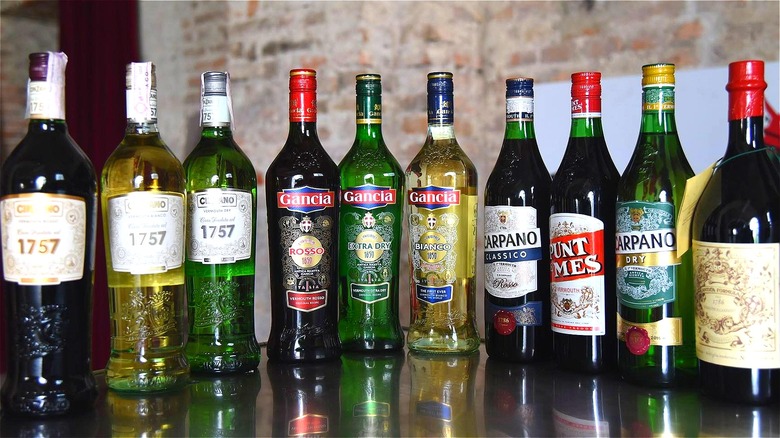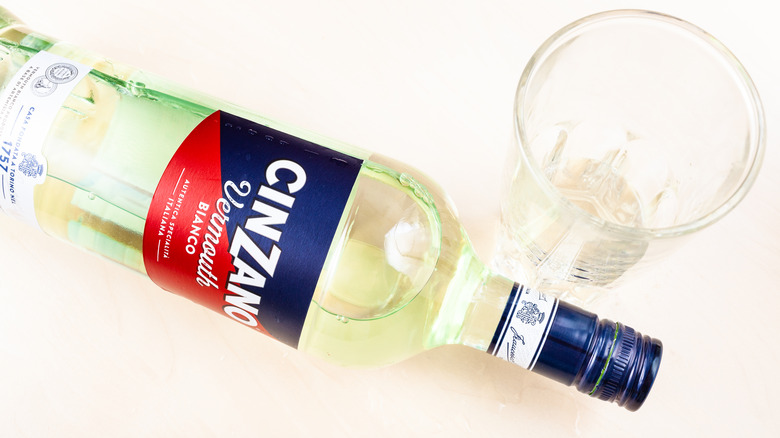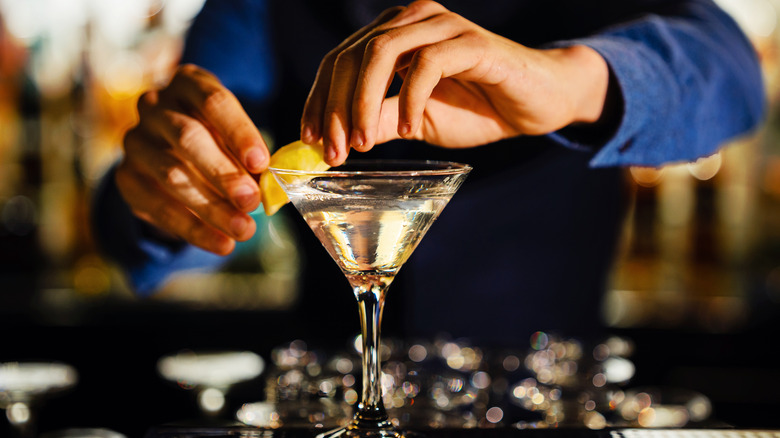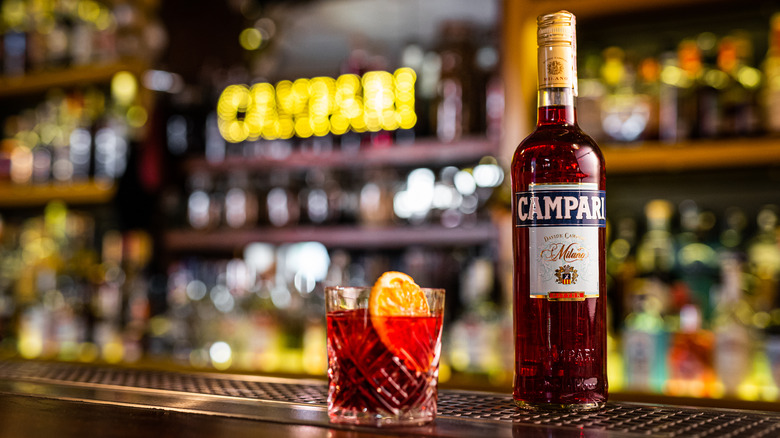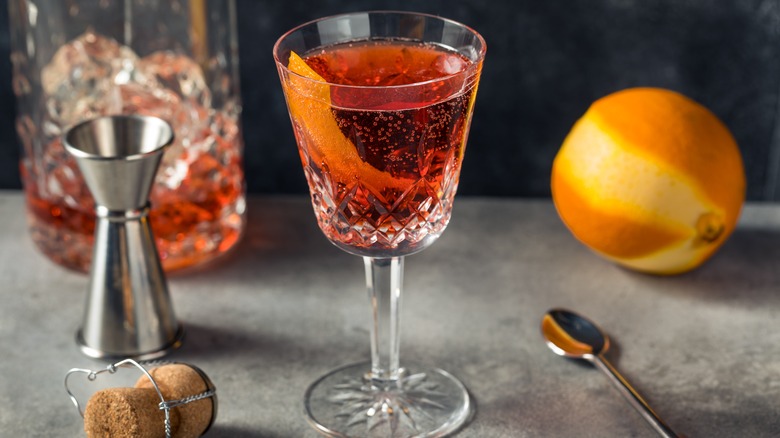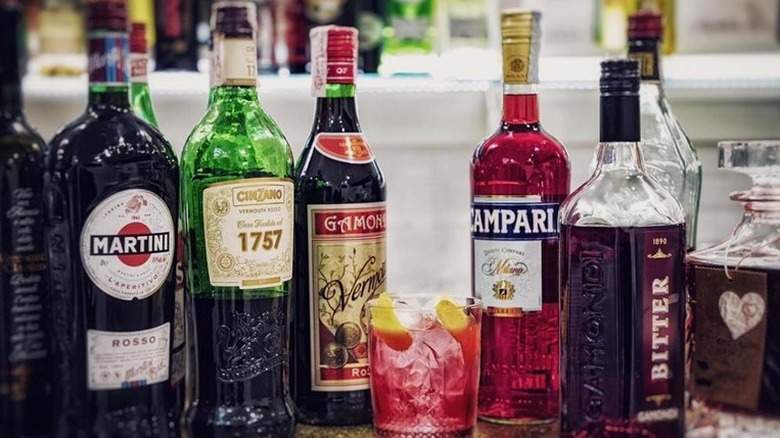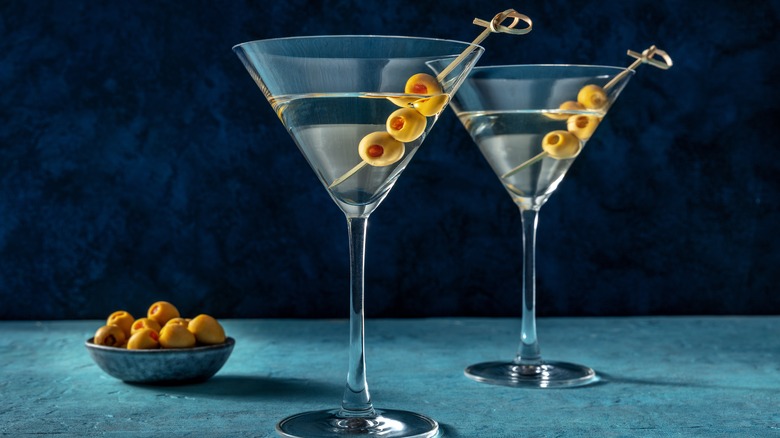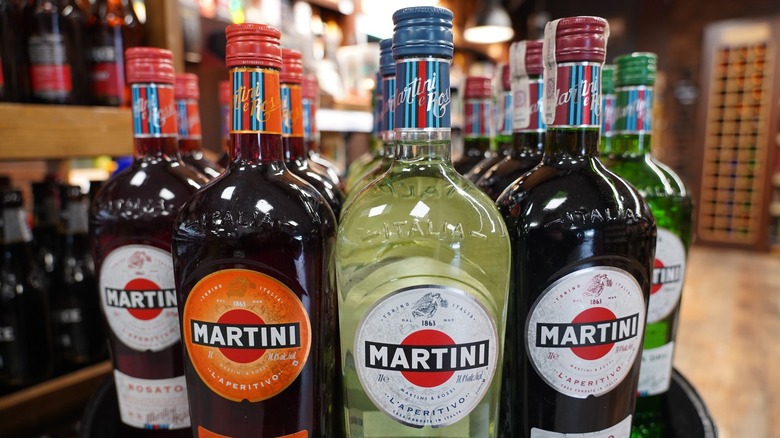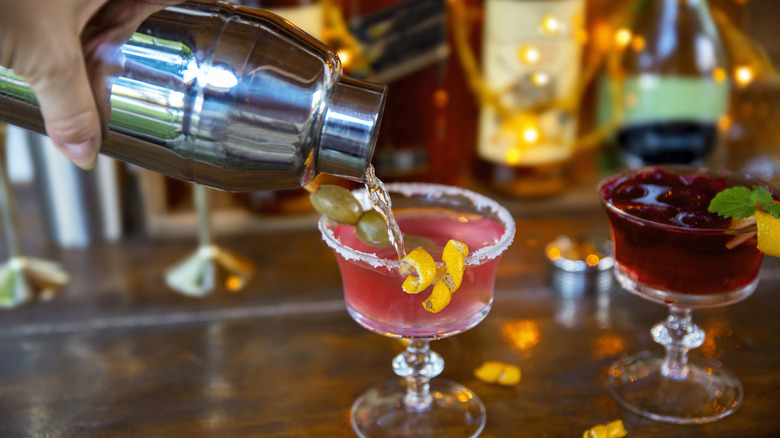Everything You've Ever Wanted To Know About Vermouth
When you think of vermouth, you might envision a lesser-used bottle that's taking up room on the bar counter or something your dad keeps in the liquor cabinet for rustling up homemade cocktails. Or perhaps you picture James Bond with his shaken not stirred vesper martini, made with gin, vodka, and just a splash of Kina Lillet – a bitter French liqueur that is commonly substituted with vermouth on modern bars.
However, despite vermouth's low-key reputation, this fortified wine is so much more than an afterthought when it comes to bartending and mixology. Still a popular aperitif in parts of Europe and South America, vermouth also has a huge variety of unique recipes and flavors that make it an extremely versatile beverage.
To find out more about vermouth and how it can be used behind the bar, we've spoken with Alec Kass, Beverage Director at Carver Road Hospitality in New York, to discover why he loves this underrated drink. "Vermouth is indispensable in a bar, honoring the rich history of the cocktail canon and showcasing respect for the classics," Kass explains. "Whether elevating a classic or crafting a modern drink, vermouth adds depth and authenticity to any cocktail experience."
What is vermouth?
Vermouth is a fortified wine that is infused with a mix of botanical herbs, roots, and spices during its production process. Herbal liqueurs and wines have a long history in Europe and were often believed to have medicinal properties. The first modern vermouth was produced in northern Italy during the late 1700s, with its invention generally credited to Antonio Benedetto Carpano, a Piedmont native, who created the recipe for Vermouth Carpona.
Flavored with a variety of herbs and spices, vermouth was given its official title in the early 1800s and was named after "Wermut" — the German word for wormwood, which was an important ingredient in the original recipe. Many modern blends still call for small amounts of Artemisia absinthium, which is partly what gives dry vermouth its bitter flavor. However, artemisia botanicals are only officially required in vermouth made in the EU. Authentic vermouth usually has an ABV of around 15-22%, making it slightly stronger than traditional wine.
During the 1800s, vermouth's popularity spread throughout Turin and into France, where it was most commonly consumed neat as an aperitif. But, vermouth cocktails were available as far back as the 1850s-60s, with craft cocktails experiencing another resurgence during the early 2000s in cities like New York and San Francisco. As Alec Kass notes, vermouth's "role in iconic drinks like the Manhattan and Negroni is a testament to its historical significance."
How is vermouth made?
Vermouth is made by fortifying wine with a spirit that has been infused with herbs and botanicals. White wine is generally used for the vermouth base, regardless of whether red or white vermouth is being produced. Muscat grapes were originally used to make northern Italian vermouth. These grapes produce sweet wines, such as Moscato and Muscat dessert wine, and this helped lend Italian red vermouth its syrupy flavor.
French vermouth producers tend to favor white grapes with higher acidity, such as Picpoul or Clairette Blanche. To fortify the wine, vermouth producers add agricultural spirits, such as grain alcohol or grape brandy, which has been infused with a botanical herb mix. Flavors are extracted from the herbs, roots, and spices through soaking or maceration or by distillation process of heating and cooling.
Vermouth recipes are all unique but common herbs and bittering agents include juniper berries, chamomile, rhubarb, and star aniseed, among others. The botanicals in vermouth are usually infused into the spirit, rather than the wine itself, although this can vary depending on the production method. The selected herbs and spices are highly flexible and can be used to represent the local terroir, or landscape and environment that the vermouth is produced in. Caramelizing agents, like brown sugar or caramel, are also added to enhance vermouth's natural sweetness and to give red vermouth its rosy color.
Why do bartenders love vermouth?
Vermouth is a vital ingredient in many iconic spirit and wine cocktails, such as the Manhattan, the Negroni, and the martini. The wide range of bespoke vermouths available means that selecting the right one is a sign of bartending expertise and reflects a deep understanding of complementary cocktail flavors. For Alec Kass, a non-traditional "mezcal Negroni" is a perfect example of this. He states, "At Rosevale Cocktail Room, our "Moonless Sky" riff nails it — mineral feldspar notes in mezcal create a haunting harmony with a jammy BroVo vermouth."
Of course, the most famous vermouth cocktail is the martini, which can be made wet or dry depending on how the vermouth is incorporated. Martinis are traditionally made using gin and vermouth, although you can also order a vodka martini that swaps out the gin. A martini that includes a whole measure of vermouth is traditionally known as a wet martini. However, the more ubiquitous version is the dry martini, which includes only a small splash of vermouth.
Many bartenders also make an extra-dry martini by swilling vermouth around a chilled glass and then pouring the vermouth away. Kass cautions against this, however, noting that, "A common mistake I often spot is people tossing the vermouth out of their martini glasses. While James Bond favored dry martinis back when industrial vermouth dominated, the game has changed with the rise of high-quality vermouth. Next time, try getting your martini wet."
Vermouth vs amaro
Vermouth and amaro are quite similar in that they are both moderately strong alcoholic drinks that are heavily infused with botanical herbs and spices. Much like vermouth, amari liqueurs have a lot of variation in terms of what herbs and spices can be used or added. This means that, like vermouth, amari are versatile and can be enjoyed as aperitifs or as curated cocktail ingredients.
However, although amari are frequently added to cocktails — Campari and vermouth are both traditional ingredients in a classic Negroni – they are more commonly associated with aperitivos or digestifs than vermouth. In contrast, vermouth is rarely served neat in the U.S. and Europe but is mostly used to add depth and complexity to cocktails. While some amaro liqueurs are quite low in alcohol, you will also find herbal spirits like Fernet and Strega which can be 40% ABV and above — much stronger than vermouth's standard ABV of under 22%.
What does vermouth taste like?
Vermouth is divided into two broad taste categories — dry and sweet — with various levels in between. Sweet vermouth tends to have a stronger, richer taste than dry vermouth, which is often lighter, zestier, and more bitter. Vermouth flavors also vary greatly based on the herbs and spices used. Depending on the terroir represented in the botanicals, different vermouth brands can lean into different flavors, highlighting certain herbs or bringing a particular spice to the fore.
This makes vermouth a really exciting beverage to try as you can sample different kinds and have a completely different flavor experience from one to the next. Given the use of plants and botanicals, many vermouths have a slightly floral, herbal, or even earthy flavor. Dry vermouths can also taste vaguely medicinal.
Many dry vermouths also have strong citrus notes, giving them a bitter flavor profile which cuts brilliantly through alcohol-heavy cocktails like a chilled gin martini with a twist. Meanwhile, sweet vermouths can add balance to a fiery rye Manhattan that's heavily infused with bitters and orange.
How to mix drinks with vermouth
Vermouth is best known as a supporting ingredient in retro cocktails, however, this by no means takes away from its importance as a mixology staple. As well as its role in the wider martini wheelhouse, vermouth features in cocktails like the bourbon or whisky-based Boulevardier, which blends Campari and vermouth, and the Jerezana – a tempting creation made with sherry, vanilla syrup, bitters, and a blend of dry and sweet vermouth. A broken spur cocktail also includes gin, vermouth, Port, and Pernod — a potent aniseed liqueur. Meanwhile, a blood and sand uses sweet vermouth and cherry brandy to add a bold, balancing element to this Scotch and orange mixer.
Vermouth can also be a surprisingly refreshing drink when mixed into a spritzer cocktail or blended with soda water. "All kinds of carbonated water pair wonderfully with vermouth!" Alec Kass explains. "A good friend of mine swore by the combination of Lacroix Coconut Soda and sherry-forward Spanish vermouth. I didn't believe him until I tried ... but it's ridiculously fantastic — definitely a drink one would "guzzle"."
Where to buy vermouth?
Vermouth is generally pretty easy to find — you don't have to shop at specialty liquor stores if you're just looking for a garden variety Martini & Rossi. This brand, and others in the same price range, can be found in the alcohol section in supermarkets like Kroger and Whole Foods. A bottle of Martini & Rossi will usually cost you somewhere between $8-12 depending on the store you choose. You can also find Martini & Rossi and various other vermouth brands for the same price or less at online retailers, such as Drizly.com, Wine Transit, and Total Wine.
Many of these online outlets also offer slightly more expensive or niche vermouth brands. For example, you can find French Noilly Prat extra dry vermouth for around $15. You can also purchase Carpano Antica vermouth or Grassoti do Torini Vermouth from Piedmont Italy — vermouth's original birthplace — for between $16-32 at some online stores.
Nutritional information about vermouth
The amount of sugar in vermouth varies depending on whether you drink sweet or dry. Extra dry vermouth has less than 30 grams of sugar per liter, while the sweetest vermouth can have upwards of 130 grams. Vermouth contains both residual sugars from the fermented grapes in the wine and also contains added sugar, although sweet vermouths use more sweeteners than dry and extra dry varieties. Sweet vermouth may be around 15% sugar, while an extra dry vermouth may be as low as 3% sugar.
A vermouth standard 1 ounce serving typically has between 45-75 calories depending on the brand. As it is a wine, not a spirit, vermouth has a lower alcohol content than many shots, which serves to lower the calories. Even sweet vermouth is relatively low in calories compared with most other spirits, despite its increased sugar content. Vermouth was also originally touted as a medicinal drink, as it contains herbs and bitters that were supposed to promote digestion. Like other wines, vermouth also contains some antioxidant properties from the grape skin residue.
Varieties of vermouth
There are many different types of vermouth and this versatile herbal drink varies according to both the brand and the region it hails from. Italian vermouth is traditionally much sweeter than French vermouth, which is typically dry. Both sweet red — or rosso — and sweet white bianco vermouth exist, however, sweet white vermouth is dry compared with rosso, which has a plummier, more rounded flavor. As well as dry, extra dry, and sweet, you can also find rose and amber vermouth.
Rose or rosado vermouth has a pink hue and is sometimes, though not always, made using rose wine. Like white vermouth, rosado has crisp, light flavors with floral undertones but it is slightly more sweet than the traditional dry styles. The color also makes it a lot of fun to add to cocktails. Amber vermouth, meanwhile, is on the dry side, has tawny coloring, and uses strong bitters and orange flavors that perfectly round out a wet martini.
How to store vermouth
Although you may sometimes see vermouth on a back bar shelf, this fortified beverage should really be stored in the fridge. While the fortification in vermouth does prolong its shelf life somewhat by increasing its alcohol content, vermouth should still be treated essentially like a white wine. Prolonged air exposure can lead to oxidation, which can dull down or sour vermouth's delicate flavors and aroma. Vermouth also contains sugar from the grapes which, over time, can lead to bacterial growth and eventually give your bottle a sharp, vinegary taste.
Storing vermouth in the fridge will help slow any bacterial growth and will help keep your vermouth fresh for around one to two months. While you can still consume it safely after this time, you may start to notice a drop off in taste quality past the eight-week mark. If you really want to enjoy the most intense flavors and scents from your vermouth bottle, you should also think about properly sealing the top with a stopper to prevent any air from getting in.
Methodology
Using Alec Kass's expert advice as the backbone for my research, I've scoured the internet to find the best information about vermouth production and its use in classic cocktail mixology. My knowledge of classic cocktail recipes also comes partly from my own experience working behind bars.
